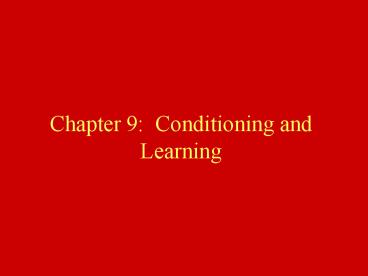Chapter 9: Conditioning and Learning - PowerPoint PPT Presentation
1 / 13
Title:
Chapter 9: Conditioning and Learning
Description:
Chapter 9: Conditioning and Learning Outline Classical conditioning Operant conditioning types of reinforcement types of reinforcement schedules role of ... – PowerPoint PPT presentation
Number of Views:150
Avg rating:3.0/5.0
Title: Chapter 9: Conditioning and Learning
1
Chapter 9 Conditioning and Learning
2
Outline
- Classical conditioning
- Operant conditioning
- types of reinforcement
- types of reinforcement schedules
- role of discriminative
- Vicarious learning
- Factors that influence modelling
3
Classical Conditioning
- Unconditioned Stimuli (national flag)
- Unconditioned Response (sense of nationalism)
- Neutral or Conditional Stimulus (candidate)
- When flag is paired with candidate, he/she
elicits a sense of nationalism.
4
Classical Conditioning (continued)
- No voluntary control
- Multiple pairing of US and CS
- Works better for behavioral responses (Pavlovian
Dog) than for cognitive/affective responses - Can be chained association can be transferred
- Influence behavior by triggering association
between conditional and neutral stimulus.
5
Operant Conditioning
- Altering behavior by associating each behavior
with consequences. - A positive consequence will increase probability
of behavior and negative will decrease. - Applicable for voluntary behaviors
6
Reinforcement
- It refers to the consequences that come with a
given behavior. - The probability of behavior depends on the
consequences of the behavior.
7
Types of Reinforcement
- Positive -- behavior is followed by a reward or a
positive consequence - Negative -- behavior followed by the removal of a
negative consequence - Punishment -- behavior followed by a negative
consequence. - Extinction -- no consequence
8
Reinforcement Schedules
- Continuous -- consequence for every time the
behavior occurs. - Fixed-Ratio -- consequence for every predefined
number of times the behavior occurs - Variable -- no set pattern
9
Pros and Cons of Different Reinforcement Schedules
- Continuous is expensive and very effective, but
changes expectations. - Fixed is less expensive, but less effective.
- Variable is less effective, but very inexpensive,
and not prone to extinction, and does not
influence expectations.
10
Shaping
- Changing behavior using small incremental changes
in behavior rather than a single big shift in
behavior.
11
Discriminative Stimuli
- The mere presence or absence of certain stimuli
can alter the likelihood of behaviors. - This is related to the concept of reinforcement
except that it occurs before the behavior. - Most promotions are examples of discriminative
stimuli.
12
Vicarious Learning
- Changing ones own behavior by observing the
behavior of others and the consequences that
occurred. - Known as modeling.
- Can be used for developing new behaviors, inhibit
undesirable behaviors, facilitate known desired
behaviors.
13
Factors Influencing Vicarious Learning (Modeling)
- Models who are attractive, credible, high-status,
experts are more effective. - Vivid and detailed portrayal of modeled behavior
and consequences increases modeling. - Perceptive and confident people are able to learn
better.































